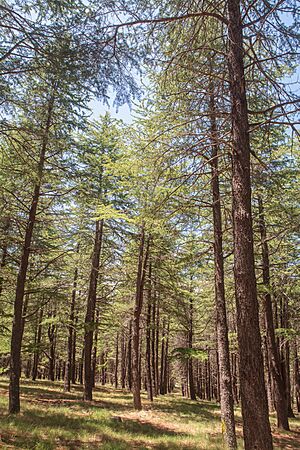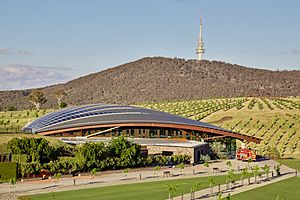National Arboretum Canberra facts for kids
The National Arboretum Canberra is a huge park in Canberra, Australia's capital city. It covers about 250 hectares (that's like 618 football fields!). This special park was created after big bushfires in 2001 and 2003. These fires sadly burned down many trees, including a large forest of Himalayan Cedar trees and a plantation of Radiata Pine. This cleared space allowed for the new arboretum to be built.
In 2004, the local government held a competition to design the arboretum. It was part of the plan to help the area recover from the bushfires. The winning idea came from landscape architects Taylor Cullity Lethlean and architects Tonkin Zulaikha Greer. They suggested planting 100 different forests and creating 100 gardens. These would feature rare, threatened, and special trees from all over the world.
Trees have been planted at the arboretum since 2005. Important visitors, like heads of government and ambassadors, have also planted special ceremonial trees. The National Arboretum Canberra officially opened in February 2013. On its opening day, more than 15,000 people visited. Since then, over a million visitors have explored its beautiful forests, landscapes, and buildings.
Contents
Exploring the Plantings

The arboretum has some older forests that were already there. These include forests of Himalayan cedar (Cedrus deodara) and cork oak (Quercus suber). These were planted a long time ago, following ideas from the city's original planner, Walter Burley Griffin. The arboretum's design fits well with Griffin's original vision for such a park.
A forest of Turkish Pine (Pinus brutia) has been planted to remember Australian service members who died in wars. This type of pine comes from the Gallipoli Peninsula in Turkey, a place important in Australian history. Also, some special Aleppo Pines (Pinus halepensis) grow on Dairy Farmers Hill. These trees grew from seeds of the famous Lone Pine tree at the Australian War Memorial.
The National Bonsai and Penjing Collection of Australia is also located here. This collection features miniature trees and landscapes, which are a beautiful art form.
Here are some of the interesting trees you can find planted at the arboretum:
- California fan palm (Washingtonia filifera)
- Chinese tulip tree (Liriodendron chinense)
- Western old white gum (Eucalyptus argophloia)
- Yoshino cherry (Prunus x yedoensis)
- Dragon tree (Dracaena draco)
- Maidenhair tree (Ginkgo biloba)
- Judas tree (Cercis siliquastrum)
- Giant redwood (Sequoiadendron giganteum)
- Camden white gum (Eucalyptus benthamii)
- Chinese rubber tree (Eucommia ulmoides)
- Horse chestnut (Aesculus hippocastanum)
- Monkey puzzle tree (Araucaria araucana)
- Bunya pine (Araucaria bidwillii)
- Weeping Snow Gum (Eucalyptus lacrimans)
- Wollemi pine (Wollemia nobilis)
- Illawarra flame tree (Brachychiton acerifolius)
Southern Tablelands Ecosystems Park (STEP)
Near the main building, called the Village Centre, is the Southern Tablelands Ecosystems Park (STEP). This area has a forest of eucalypt trees that are typical of the Southern Tablelands region. The goal of STEP is to create a regional botanic garden and a center for education and ecosystem recovery. It has 16 different eucalypt species and many other plants like shrubs, grasses, and flowers. These plants provide a natural home for various animals.
Buildings and Public Spaces
The arboretum offers amazing views of Canberra. It also has an outdoor stage and an amphitheatre for events. The main buildings include the Village Centre, which is a cool building made of timber. Inside, you'll find a cafe, a restaurant, a gift shop, and an exhibition about the arboretum. There's also a smaller building called the Margaret Whitlam Pavilion, used for events and ceremonies. The stone used in the visitor center comes from a town called Wee Jasper, New South Wales, near Canberra.
Public Artworks
The arboretum is home to several large and interesting public art pieces.
On a hill that overlooks the arboretum, you'll see a sculpture called "wide brown land". This artwork spells out a famous line from the poem My Country by Dorothea Mackellar. The letters are based on her own handwriting! It's about 35 meters long and 3 meters tall.
At the very top of Dairy Farmers Hill, there's another artwork called 'Nest III'. It's made from found objects and looks like an eagle sitting on a nest.





